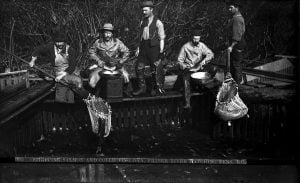
Wildlife
The great green shark hunt
Can British Columbia’s spiny dogfish make the grade as the world’s first “sustainable” shark fishery?
- 3319 words
- 14 minutes
This article is over 5 years old and may contain outdated information.
Environment


It took them three years to get the conditions just right, but marine biologists at New Brunswick’s St. Andrews Biological Station (SABS) finally got their northern orange-footed sea cucumbers to breed in early May.
“Everyone has their cues for spawning,” says Shawn Robinson, a research scientist at the Fisheries and Oceans Canada facility on the Bay of Fundy. “We were keeping them inside, exactly mimicking natural conditions, but they weren’t having any of it.”
Yet when the frigid cucumbers were moved to a greenhouse this spring, where they had natural photoperiods and the water was colder, they loved it. “Sure enough, we have a bunch of larvae in our tanks now and cells are dividing away,” says Robinson.
Persuading fussy bottom feeders to get frisky might not sound like a major breakthrough, but it’s a key element of a project with big implications for more ecologically integrated and sustainable aquaculture (fish farming). SABS has already had success spawning green sea urchins for this purpose, and similar research projects are underway in Atlantic nations such as Spain, Scotland, Norway, Sweden and Germany.
Canada produces 80 thousand tonnes of farmed salmon alone each year. Most of these farms are in New Brunswick and British Columbia, accounting for about 10,000 jobs and close to $550 million annually — about 75 per cent of the country’s total finfish and shellfish aquaculture value. But all those salmon milling around in series of underwater cages leads to concentrations of feces and excess nutrients in “impact zones” of about 50 metres on all sides. And as with land-based agriculture, buildup of organic matter and nutrients translates to heightened bacteria levels.
“Things can always be done better,” says SABS biologist Terralynn Landry. “We rely on these [marine farms] to grow the food we need to eat, so the question for us is, once those nutrients are in the water, how do you get them out?”
Salmon are highly efficient when it comes to taking up and using nutrients, converting at a rate of about 30 per cent — far more efficient than humans, cows, pigs or chickens. But the SABS researchers are looking at that other 70 per cent, the particulates of food that the salmon miss or the undigested nutrients that are pooped out and settle on the shallow ocean bottom. That’s where the sea cucumbers and urchins come in.
Both East Coast species are good at gathering up and processing organic particulates.
“We need to build ‘synergistic’ systems that will actually capture some of those unused nutrients,” says Robinson, “so why not use biological filters?” For that the researchers required animals with distinct characteristics: they had to be “growable” on a large scale (hence the excitement about larval sea cucumbers), and they had to be capable of eating particulates of organic waste of a certain size (clams, mussels and other shellfish strain finer particulates than is practical for fish-farm cleanup). The cucumbers pop their 10 branched, sticky tentacles into their mouths as they move along the seafloor — “like they’re licking particulates off their fingers,” says Robinson. Urchins, meanwhile, can graze along in groups, cutting even large pieces of matter into digestible chunks.

And the animals’ value doesn’t end at their ecological services. Most Canadians may not be warm to the idea of urchins and sea cucumbers on their dinner plates, but Lander says the creatures have quite a high value on the world market, especially in Asia, where sea cucumbers in particular are considered a luxury food. And even North American culinary tastes can change: “Look at mussels,” says Robinson. “Back when I was growing up in P.E.I., eating them was unheard of. Now there’s a huge mussel industry there, and huge demand. It’s more of a presentation and education thing.”
The next steps are to work with New Brunswick’s Cooke Aquaculture to generate more juvenile urchins and cucumbers and put them out on farms. Then the SABS team can measure how fast they consume available organic matter, and calculate how large stocks will have to be to make a reasonable dent in fish farm waste. That could mean spawning and distributing millions of both species. Meanwhile, the biologists are also exploring the best way to corral them so they’re efficiently connected to the salmon, the source of all that nutrition.
“The labs that have been set up in the last few years to grow and study the life cycles of these animals have found such great potential,” says Lander. “Producing these larvae — which might start out just 100 microns in size — is a monumental task, but the ecological and monetary potential for Canada is also massive. Probably because they’re invertebrates, they’ve been overlooked for much too long.”

Are you passionate about Canadian geography?
You can support Canadian Geographic in 3 ways:

Wildlife
Can British Columbia’s spiny dogfish make the grade as the world’s first “sustainable” shark fishery?

History
From their beginnings in the late 19th century, salmon hatcheries have gone from cure to band-aid to crutch. Now, we can’t live without manufactured fish.

People & Culture
A moratorium on cod fishing that was supposed to last two years has now lasted 30. What will it take to rebuild cod stocks — and a way of life?

Environment
Struggle and success in Atlantic Canada, where aquaculturists strive to overcome climate change and contamination while chasing a sustainable carbon footprint